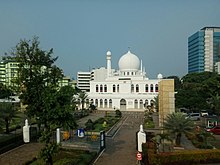
The Al-Azhar University is a public university in Cairo, Egypt. Associated with Al-Azhar Al-Sharif in Islamic Cairo, it is Egypt's oldest degree-granting university and is known as one of the most prestigious universities for Islamic learning. In addition to higher education, Al-Azhar oversees a national network of schools with approximately two million students. As of 1996, over 4,000 teaching institutes in Egypt were affiliated with the university.

Istiqlal Mosque in Jakarta, Indonesia is the largest mosque in Southeast Asia and the ninth largest mosque in the world in terms of worshipper capacity. Built to commemorate Indonesian independence, this national mosque of Indonesia was named "Istiqlal", an Arabic word for "independence". The mosque was opened to the public on 22 February 1978. Within Jakarta, the mosque is positioned next to Merdeka Square, the Jakarta Cathedral (Catholic), and also of the Immanuel Church (Reformed).
Islamic religious leaders have traditionally been people who, as part of the clerisy, mosque, or government, performed a prominent role within their community or nation. However, in the modern contexts of Muslim minorities in non-Muslim countries as well as secularised Muslim states like Turkey, and Bangladesh, the religious leadership may take a variety of non-formal shapes.

Sheikh Mahmoud Shaltut was an Egyptian figure best known for his attempts in Islamic reform. A disciple of Mohammad Abduh's school of thought, Shaltut rose to prominence as Grand Imam of Al-Azhar during the Nasser years from 1958 until his death in 1963.

Kebayoran Baru is a district in the administrative city of South Jakarta, Indonesia. The name was derived from a planned satellite city of the same name which was developed in the post-war period. Kebayoran Baru was the last residential area to be developed by the Dutch colonial administration. The urban planning was laid in a concept of the Garden city movement, consisting of a well-planned residential area, a shopping center, and a business district, supported with civic facilities such as schools, places of worship, hospitals, and parks. Today, the district is home to many important government institutions, such as the Indonesia Stock Exchange building, the ASEAN Headquarters building, the National Police headquarters, and the City Hall of South Jakarta. Sudirman Central Business District is also located in the district.
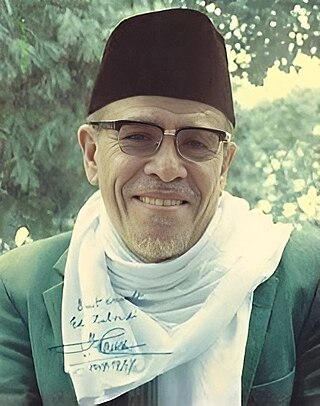
Abdul Malik Karim Amrullah, better known by his pen name Hamka was an Indonesian ʿālim, philosopher, writer, novelist, lecturer, politician and journalist.

The Great Mosque of Central Java is a mosque in the city of Semarang, Central Java, Indonesia.
The following is a timeline of the history of the city of Jakarta, Indonesia.

The Ganting Grand Mosque is a Sunni mosque located in Ganting, Padang, West Sumatra, Indonesia. Construction began in 1805, making it the oldest in Padang and one of the oldest in Indonesia. It is a Cultural Property of Indonesia.

Patung Pemuda Membangun is a statue located at the southern end of Jalan Jenderal Sudirman, Jakarta, Indonesia. The statue marks the entrance to Kebayoran Baru subdistrict in South Jakarta.
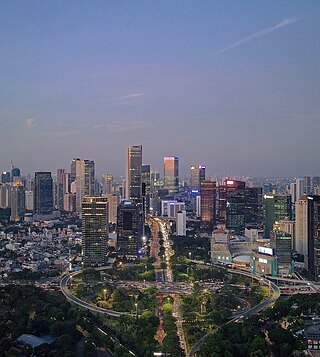
Semanggi Interchange or commonly known as Semanggi Bridge is a major road interchange in Jakarta, Indonesia which consists of a cloverleaf interchange —the first, and until the 1990s the only, of its kind in Indonesia—and a partial turbine interchange. Two main roads of the city Gatot Subroto Road and Sudirman Road intersect at this interchange. Initially completed in 1962 as part of several projects intended to be completed before the 1962 Asian Games, the interchange is a landmark and an important part of the Golden Triangle of Jakarta.

Masjid Jami Kampung Baru Inpak, also known as Masjid Kampung Baru or Bandengan Mosque, is one of the oldest mosques in Jakarta, Indonesia. It is located at Jalan Bandengan Selatan, Pekojan, Tambora, Jakarta, close to Masjid Al-Anshor. It is one of the mosques that was built by Muslim merchants from India who used to travel to and live in Batavia. The mosque has been designated as cultural heritage by the provincial government of DKI Jakarta.

Islam is the most common religion in the Indonesian province of West Sumatra, embraced by 97.42% of the population. The Muslim population increases to 99.6% if it excludes the Mentawai Islands, where the majority of the non-Muslim (Protestant) West Sumatrans reside. Islam in West Sumatra is predominantly Sunni, though there is a small Shia Islamic pocket within the coastal city of Pariaman. The Minangkabau people, indigenous to West Sumatra, comprise 88% of the West Sumatran population today and have historically played an important role within Indonesia's Muslim community. Up until today, the region is considered one of the strongholds of Islam in Indonesia.

Mosque architecture in Indonesia refers to the architectural traditions of mosques built in the archipelago of Indonesia. Initial forms of the mosque, for example, were predominantly built in the vernacular Indonesian architectural style mixed with Hindu, Buddhist or Chinese architectural elements, and notably didn't equip orthodox form of Islamic architectural elements such as dome and minaret. Vernacular architectural style varies depending on the island and region.
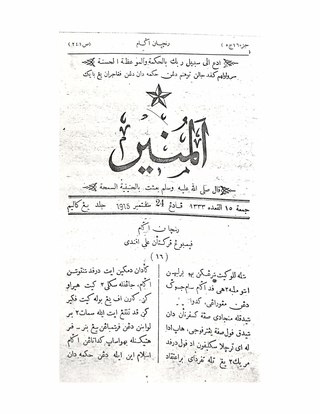
Al-Munir was an Islamic magazine, written in Arabic-Malay, published in Padang from 1911 until 1915. Inaugurated by the initiative of Abdullah Ahmad in early April 1911, Al-Munir was listed as the first Islamic mass media in Indonesia. The magazine was often associated with Al-Imam magazine published under the direction of Sheikh Tahir Jalaluddin in Singapore during 1906-1909. In addition to Abdullah Ahmad, several religious figures such as Abdul Karim Amrullah, Muhammad Thaib Umar and Sutan Muhammad Salim were recorded in the ranks of the editorial board.
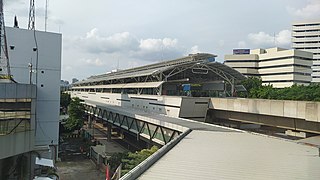
ASEAN Station is a rapid transit station on the North-South Line of the Jakarta MRT in Jakarta, Indonesia. The station is located in the Gunung area, Kebayoran Baru, South Jakarta and is built on Jalan Sisingamangaraja XII. This station is the northernmost elevated station for the first phase of the Jakarta MRT project before entering the underground line. It is located between Senayan and Blok M BCA stations, and has the station code SSM. It is connected to the TransJakarta at the. The station is located not far from the Secretariat of the Association of Southeast Asian Nations. The station is connected to the CSW-ASEAN TOD for Transjakarta's Corridor 13 service via a pedestrian bridge that has been in operation since December 2021. The station has only two railroad tracks and has no switches.

Al-Istiqlal Great Mosque, Murung Raya is the largest mosque in the entire Murung Raya Regency, Central Kalimantan, Indonesia. This great mosque is located on Jendral Sudirman Street, in the district of Murung, Murung Raya Regency. This great mosque is one of the most popular icons of Murung Raya Regency.
